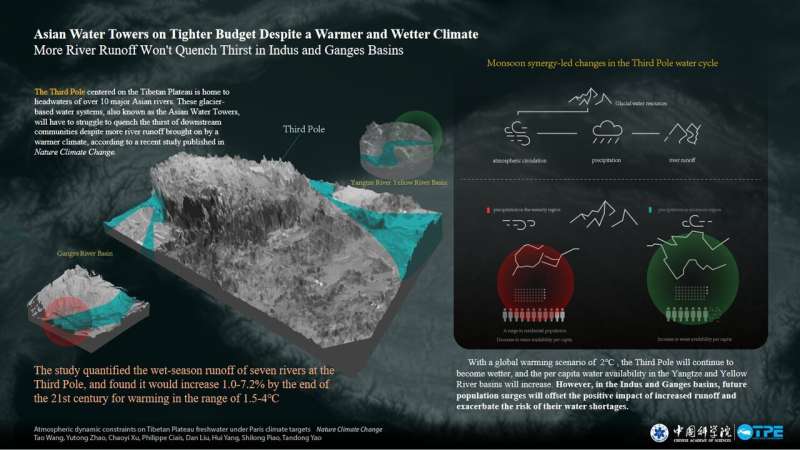Asian water towers on tighter budget despite a warmer and wetter climate

The 'Third Pole' centered on the Tibetan Plateau is home to headwaters of over 10 major Asian rivers. These glacier-based water systems, also known as the Asian Water Towers, will have to struggle to quench the thirst of downstream communities despite more river runoff brought on by a warmer climate, according to a recent study published in Nature Climate Change.
By constraining earth system models for precipitation projections, together with estimated glacier melt contributions, the study quantified the wet season runoff of seven rivers at the Third Pole, and found it would increase 1.0-7.2% by the end of the 21st century for warming in the range of 1.5-4°C. However, the study also showed that rising water demands from the growing population will outweigh warming in determining water scarcity in the Indus and Brahmaputra basins, especially at higher warming levels. "Regretfully, a large proportion of the local population will continue to experience severe water stress even with a wetter climate," said Wang Tao, lead author of the study and a professor at the Institute of Tibetan Plateau Research, Chinese Academy of Sciences.
"Estimates of future Third Pole precipitation in earlier IPCC reports vary greatly, indicating huge uncertainties," said Yao Tandong, co-author of the study and co-chair of Third Pole Environment (TPE), an international science program for the interdisciplinary study of the region. "By constraining earth system models on the basis that westerly-monsoon interaction is the main driver of water cycle changes at the Third Pole, we significantly increased the confidence of future precipitation projection," said Yao.
This study also highlighted the need for policies promoting adaptation in the region. "We recommend measures such as increasing crop use efficiency and dam regulations in these basins to secure future water, food security and environmental sustainability under the Paris climate targets" said Yao.
More information: Atmospheric dynamic constraints on Tibetan Plateau freshwater under Paris climate targets, Nature Climate Change (2021). DOI: 10.1038/s41558-020-00974-8 , www.nature.com/articles/s41558-020-00974-8
Journal information: Nature Climate Change
Provided by Chinese Academy of Sciences



















